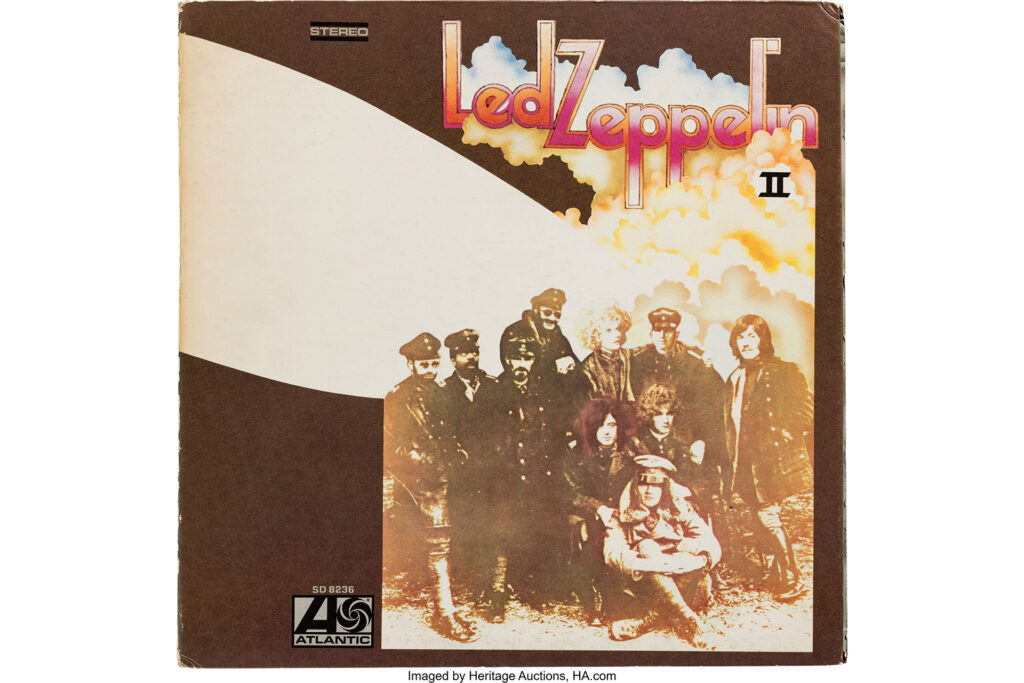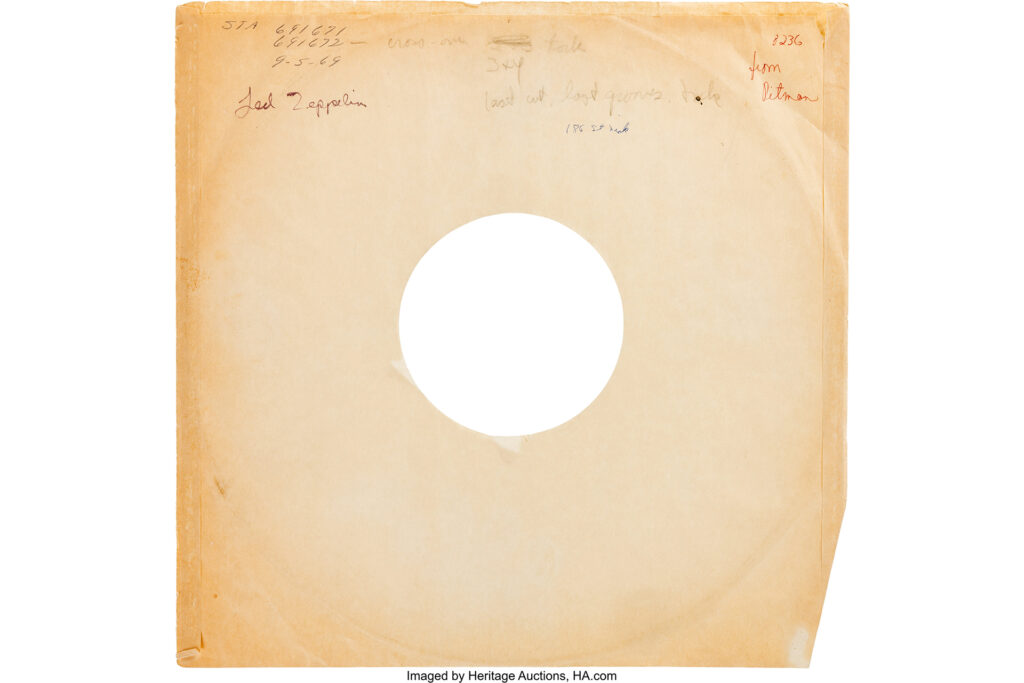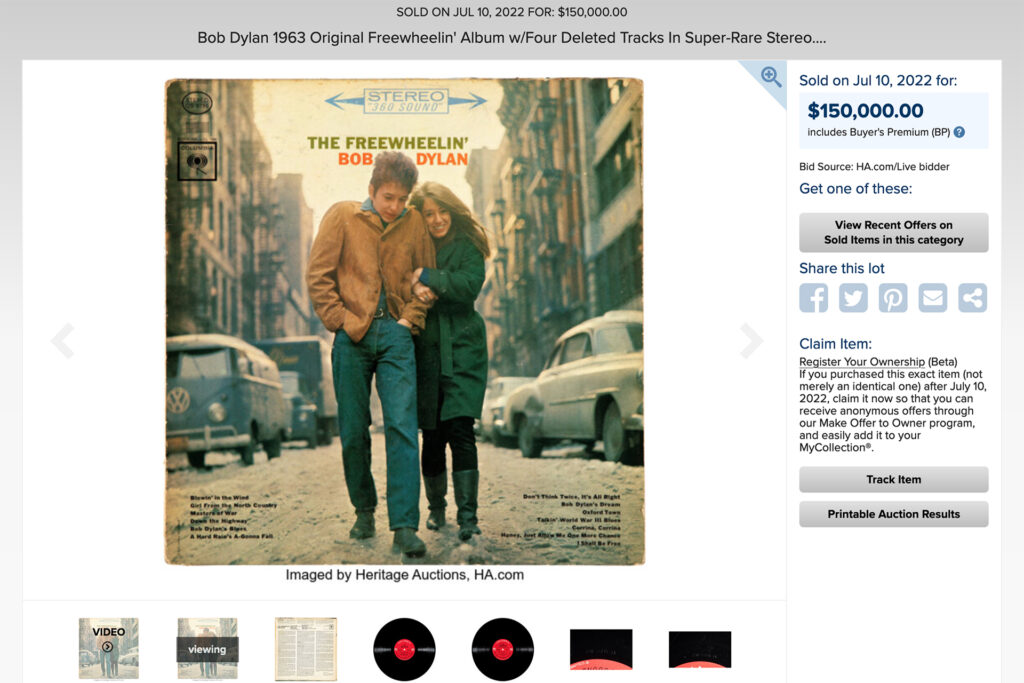Heritage Auctions of Dallas is in the early days of a one-month auction of Music Memorabilia. The auctions will end on December 4, 2024. The two headlining lots are the original illustration art for the album cover of Elton John’s Captain Fantastic and the Brown Dirt Cowboy (1975) and legendary mastering engineer Bob Ludwig’s personal copy of the test pressing for his legendary “Hot Cut” original version of Led Zeppelin II. Click here to see the lots.
The single item that is most likely to attract a lot of attention is Bob Ludwig’s personal test pressing for Led Zeppelin II and we say that with all due respect to Alan Aldridge’s illustration for Elton John’s Captain Fantastic. With framed dimensions of 22.75 by 35.5 inches, it is sure to make an impressive piece of wall candy for a well-heeled fan.

By the way, reading Heritage Auctions’ description of Alan Aldridge’s illustration, we learned that Aldridge was inspired by Hieronymus Bosch’s The Garden of Earthly Delights, which was painted circa A.D. 1500. Once you learn that, Aldridge’s work does seem to snap into focus. But we also think that hi-fi fans will be more interested in the legendary Led Zeppelin II “RL Hot Cut” test pressing.
It’s a famous rock and roll story… Eddie Kramer, director of engineering and mixing at A & R Studios, asked the 23-year old Bob Ludwig if he could make Led Zeppelin’s work-in-progress new album, which had already been mixed and mastered, even more dynamically impactful. Apparently, Kramer used the term “Hotter” but the intent was that the dynamics be more impactful (rather than, that the high frequencies would have more sizzle).
Therefore the first thing to remember is that, even though the “RL” version of Led Zeppelin II is often referred to as a “Hot Mix,” that is not the case. That label is somewhat misleading. Bob Ludwig did not remix the album using the original eight tracks from the recording sessions. Instead, Bob cut new lacquers from the mixed-down stereo master tapes. Those lacquers, from which the test pressing stampers were made, are distinguished by the scribed initials “RL” inside the dead-wax area.
Nearly everybody in a position of power at the time loved Bob Ludwig’s new cut, which was chosen for the commercial release. A quick look at the stats reveals how significant Led Zeppelin II was. The album was released in the United States on October 22, 1969, with advance orders for 400,000 copies. Despite the fact that many critics were less than enthusiastic, within six months, Led Zeppelin’s second studio recording had sold an impressive three million copies. The case can be made that Led Zeppelin was the first heavy metal album.

LPs of the original Bob Ludwig cutting, the actual first Led Zeppelin commercial release, were distributed to radio stations and to music critics. Nobody complained about technical problems while playing the LPs. Indeed, as a precautionary check, Bob had taken his test pressing to a friend’s house, to play it on his friend’s turntable.
Unfortunately, Ahmet Ertegun’s niece’s cheap record player mistracked on Bob Ludwig’s Led Zeppelin II Hot Cut LP’s robust bass. Even more unfortunately, without investigating, Ertegun told his employees to recall all the LPs and to trash them. He then had staff engineers remaster the album from a cassette tape, with bass cut and dynamic compression. (audiophile gasps are fully warranted here…)
Very quickly, the remaining Bob Ludwig’s “RL” Hot Cut LPs became lusted-after collectors’ items. A “Mint” copy sold not too long ago on eBay for more than $3,400.
Bob Ludwig made an oral-history video for the Audio Engineering Society about his experiences with Led Zeppelin II:
(Side note: Bob Ludwig mistakenly states in this AES video that it was Ahmet Ertegun daughter’s phonograph. But Ahmet Ertegun apparently was childless, so it was more likely a niece’s record player.)
So now, Bob Ludwig has now consigned his personal Led Zeppelin II test pressing to Heritage Auctions. The expectation is that Bob’s Led Zeppelin personal test pressing will set a new record (pun intended). We asked record producer and music and audio journalist John Marks, who has “eyeball estimated” more than 14,000 LPs, for his thoughts:
Heritage Auctions is the world’s foremost auction house for enthusiast collectibles; but they also manage to set records in traditional auction house categories such as American paintings. Heritage Auctions recently sold a George Herman “Babe” Ruth New York Yankees baseball game-worn jersey for $12,000,000.

Closer to home, Heritage sold a Bob Dylan record-store record—another case of an original issue’s being hastily recalled—-for $150,000. Therefore, I think that whatever result Heritage Auctions achieves what Bob Ludwig’s Led Zeppelin II personal test pressing, almost by definition will be the best result possible.
The big money will only pony up during the last 24 hours of this auction. So don’t be misled by where the auction price is today. My guess is that the bidding should end up north of where the Dylan record ended up thus well above $150,000.
Are you in?
About the Career of Mastering Engineer, Bob Ludwig
Bob Ludwig is one of the most respected mastering engineers in the recording industry, with a career spanning more than five decades. Known for his precision, consistency, and ability to bring out the best in recordings across genres, Ludwig’s work has been a part of thousands of albums and singles by major artists from the 1960s through the present day. His mastering credits include some of the most commercially successful and critically acclaimed records in modern music history.
Ludwig was born in Savannah, Georgia, in 1945, and raised in New York. He developed an early interest in music and audio, playing trumpet in school and experimenting with tape recorders. He went on to attend the Eastman School of Music at the University of Rochester, where he earned both a bachelor’s and a master’s degree. While at Eastman, Ludwig studied classical music and recording technology, a combination that would influence his technical and musical approach throughout his career.
After graduation, Ludwig began his professional work in audio at the esteemed classical label RCA Red Seal. From there, he joined A&R Recording in New York City, where he worked under Phil Ramone. In 1968, he moved to Sterling Sound, a mastering facility that would become a major part of his early legacy. At Sterling, Ludwig quickly established himself as a go-to mastering engineer for both rock and pop records. His attention to detail and ability to prepare masters that translated well across different playback systems made him a preferred choice for producers, engineers, and labels.
Ludwig’s move to Masterdisk in the 1970s allowed him even greater creative control and access to leading artists. During his time at Masterdisk, he worked on landmark albums by artists such as Led Zeppelin, Bruce Springsteen, Dire Straits, and U2. He was responsible for mastering Springsteen’s Born to Run and Born in the U.S.A., as well as Dire Straits’ Brothers in Arms. These records helped define the sound of their respective decades and demonstrated Ludwig’s role in shaping final commercial releases.
In 1993, Ludwig founded Gateway Mastering Studios in Portland, Maine. The facility was built to his specifications and has remained independent since its founding. At Gateway, Ludwig has continued to work with high-profile clients, mastering albums for artists including Radiohead, Daft Punk, Beck, Coldplay, and Beyoncé. His work also extends to classical, jazz, and soundtrack recordings, including releases for Deutsche Grammophon, Nonesuch, and Sony Classical.
Ludwig has been at the forefront of format transitions throughout his career, including vinyl, CD, SACD, DVD-Audio, Blu-ray, and digital downloads. He has often emphasized the importance of preserving dynamic range and fidelity, particularly during periods when commercial trends pushed toward louder, more compressed masters. His perspective on the so-called “loudness wars” has made him a frequent voice in discussions about mastering quality, and he has consistently advocated for audio that remains faithful to the artist’s intent and the music’s dynamics.
In recent years, Ludwig has also mastered numerous reissues and box sets, bringing archival material up to modern sonic standards while respecting the original recordings. His approach combines both historical context and current mastering tools, using analog gear and digital workstations to achieve balanced, high-resolution results.
Throughout his career, Ludwig has received multiple Grammy Awards, including several for Best Engineered Album and for his mastering contributions to Album of the Year winners. He has also been honored by the TEC Awards and the AES (Audio Engineering Society), and he is often invited to speak on industry panels related to audio mastering and production.
What sets Ludwig apart from many of his peers is the breadth and consistency of his catalog. He has worked with artists across multiple generations, from Jimi Hendrix to contemporary performers, without dramatically altering his process or reputation. His name on a mastering credit is often taken as a sign of technical reliability and professionalism.
Ludwig has remained active in mastering well into his seventies, running Gateway Mastering with a small, focused team. His career is notable not just for its duration or list of clients, but for its role in shaping how records sound to listeners worldwide. Rather than altering the essence of recordings, Ludwig’s work is often described as making them more complete—translating what was captured in the studio into something that works on a wide range of systems without sacrificing musical nuance.
Bob Ludwig’s legacy is built on consistency, a strong understanding of both musical and technical aspects of sound, and a clear respect for the role of mastering in the recording process. His contributions continue to influence the standards by which albums are judged and enjoyed by audiences around the world.




As the say in the South, “Well, Shut My Mouth.”
The RL LZII Test Pressing grossed $35,000. Respectable, but not up there with the Bob Dylan Canadian Stereo Recalled Mint Record-Store LP.
Lesson learned, I guess.
john